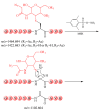[Precise identification of O-linked β- N-acetylglucosamine peptides based on O-mesitylenesulfonylhydroxylamine elimination reaction]
- PMID: 34677013
- PMCID: PMC9404036
- DOI: 10.3724/SP.J.1123.2020.12024
[Precise identification of O-linked β- N-acetylglucosamine peptides based on O-mesitylenesulfonylhydroxylamine elimination reaction]
Abstract
O-linked β-N-acetylglucosamine (O-GlcNAc), an important post-translational modification of proteins, plays an essential role in maintaining normal biological activities of organisms. Studies have shown that the disruption of O-GlcNAc homeostasis is closely associated with various human diseases. Therefore, large-scale enrichment and identification of O-GlcNAc proteins is important for exploring diagnostic biomarkers of clinical diseases. O-GlcNAcylation is substoichiometric, and its glycosidic bond is unstable; hence, the enrichment and identification of O-GlcNAc proteins remains a challenge. Recently, metabolic labeling technology with per-O-acetylated unnatural monosaccharides has been introduced to enrich O-GlcNAc proteins or peptides in cells. However, azidosugars can also react with the thiol group of cysteine to form cysteine thiol-azidosugar artificial modification as a byproduct in cell metabolism, which interferes with the identification of O-GlcNAc proteins or peptides. Therefore, the development of a methodology for the specific and complete removal of cysteine thiol-azidosugar artificial modification is necessary. O-Mesitylenesulfonylhydroxylamine (MSH) is an oxidizing and aminating reagent with great potential to oxidatively eliminate the cysteine thiol modification to dehydroalanine. Hence, it is worthwhile to probe whether MSH can eliminate cysteine thiol-azidosugar artificial modification. Two cysteine thiol-azidosugar artificial modifications were synthesized successfully by incubating thiol standard peptides with tetraacetylated N-azidoacetylgalactosamine (Ac4GalNAz) in sodium carbonate buffer (200 mmol/L, pH 10) at 37 ℃ for 90 min. Then, the reaction conditions for MSH oxidative elimination were optimized to completely remove cysteine thiol-azidosugar artificial modification. Sodium phosphate buffer (50 mmol/L, pH 8.0) was selected to protect the O-GlcNAc modification due to its mild nature. After extensive investigation, the optimized reaction conditions were established as 95 ℃ (reaction temperature) and 30 min (reaction time). Both cysteine thiol-azidosugar artificial modifications could be removed completely under these conditions. Furthermore, two azide-labeled O-GlcNAc (N3-O-GlcNAc) peptides were used to assess whether MSH destroyed the O-GlcNAc modification at the same time. The results showed that the two N3-O-GlcNAc peptides were stable after treatment with MSH at 95 ℃ for 30 min. In short, with excess MSH, the N3-O-GlcNAc peptides were stable, but the cysteine thiol-azidosugar artificial modification was exhausted in sodium phosphate buffer (50 mmol/L, pH 8.0) at 95 ℃ for 30 min. Moreover, both O-GlcNAc modification and cysteine thiol-azidosugar artificial modification exist in cell metabolism. This method can not only remove cysteine thiol-azidosugar artificial modification but also ensure the stability of O-GlcNAc modification. There is growing evidence that O-GlcNAcylation mainly occurs in proteins in the cytoplasm and nucleus, and that most O-GlcNAc proteins are involved in important biological signaling pathways. The nuclear and cytoplasmic proteins incubated with Ac4GalNAz in HeLa cells were selected as a model system. After the nuclear and cytoplasmic proteins were digested into peptides, MSH was applied to remove cysteine thiol-azidosugar modification. In addition, 51 peptides for the elimination of the cysteine thiol-azidosugar artificial modification were identified, indicating that MSH can remove the interference of cysteine thiol-azidosugar artificial modification in cell metabolism. Biotin probe and streptavidin dynabeads were subsequently used to label and enrich N3-O-GlcNAz peptides in cell metabolism. Finally, 157 O-GlcNAc peptides attributed to 130 proteins were identified. To better understand the functional roles of O-GlcNAc proteins, gene ontology analysis was performed. Cell component analysis showed that the identified O-GlcNAc proteins were mainly distributed inpostsynaptic density, cytoplasm, and condensed nuclear chromosome. The proteins were mostly involved in biological processes, including cell division, excitatory postsynaptic potential, and microtubule-based movement. The proteins responsible for transferase activity, transferring acyl groups, histone acetyltransferase activity, and microtubule binding were highly enriched, indicating that O-GlcNAc proteins play important roles in cells. In summary, this work developed an approach to enrich O-GlcNAc peptides precisely in metabolic labeling by removing cysteine thiol-azidosugar artificial modification with MSH. This methodology provides a new strategy for the application of metabolic labeling technology with unnatural monosaccharides in glycoproteomics analysis.
氧连接氮乙酰葡萄糖胺(O-GlcNAc)是一种重要的蛋白质翻译后修饰,它在维持机体正常的生命活动中发挥着重要作用。许多研究证实,O-GlcNAc糖基化修饰稳态的破坏与人类多种疾病的发生相关,大规模富集鉴定O-GlcNAc糖基化修饰蛋白有助于发现新的临床疾病诊断标志物。由于O-GlcNAc糖基化修饰丰度较低,形成的糖苷键不稳定,O-GlcNAc糖基化修饰蛋白/肽段的富集鉴定面临一定挑战。近年来,全乙酰化的非天然糖代谢标记技术被广泛应用于O-GlcNAc糖基化修饰蛋白/肽段的富集鉴定。然而,最新的研究发现,在细胞代谢标记过程中,全乙酰化的非天然单糖会同时标记半胱氨酸的巯基而引入半胱氨酸巯基-叠氮糖人为修饰物。该副反应在一定程度上干扰了O-GlcNAc糖基化修饰蛋白/肽段的富集鉴定。鉴于此,研究发展了一种通过三甲基苯磺酰羟胺(MSH)特异性氧化消除半胱氨酸巯基-叠氮糖人为修饰物的方法,进而显著提高O-GlcNAc糖基化修饰肽段的精准鉴定。该方法建立于温和的磷酸钠缓冲液(50 mmol/L, pH=8)体系,利用过量的MSH,于95 ℃避光振荡反应30 min,可完全消除半胱氨酸巯基-叠氮糖人为修饰物。该方法应用于Hela细胞中,可有效消除叠氮全乙酰化半乳糖胺(Ac4GalNAz)代谢产生的半胱氨酸巯基-叠氮糖人为修饰物,从而成功富集鉴定到157条O-GlcNAc糖基化修饰肽段,归属于130个蛋白质。该方法有效去除了半胱氨酸巯基-叠氮糖人为修饰物对代谢标记结果的干扰,为非天然糖代谢标记技术在糖蛋白组学分析中的应用提供了新的研究策略。
Keywords: O-linked β-N-acetylglucosamine (O-GlcNAc); O-mesitylenesulfonylhydroxylamine (MSH); cysteine thiol-azidosugar artificial modification; enrichment and identification; metabolic labeling.
Figures
Similar articles
-
Metabolic cross-talk allows labeling of O-linked beta-N-acetylglucosamine-modified proteins via the N-acetylgalactosamine salvage pathway.Proc Natl Acad Sci U S A. 2011 Feb 22;108(8):3141-6. doi: 10.1073/pnas.1010045108. Epub 2011 Feb 7. Proc Natl Acad Sci U S A. 2011. PMID: 21300897 Free PMC article.
-
Comparative analysis of Cu (I)-catalyzed alkyne-azide cycloaddition (CuAAC) and strain-promoted alkyne-azide cycloaddition (SPAAC) in O-GlcNAc proteomics.Electrophoresis. 2016 Jun;37(11):1431-6. doi: 10.1002/elps.201500491. Epub 2016 Mar 1. Electrophoresis. 2016. PMID: 26853435 Free PMC article.
-
Mapping sites of O-GlcNAc modification using affinity tags for serine and threonine post-translational modifications.Mol Cell Proteomics. 2002 Oct;1(10):791-804. doi: 10.1074/mcp.m200048-mcp200. Mol Cell Proteomics. 2002. PMID: 12438562
-
The hexosamine signaling pathway: deciphering the "O-GlcNAc code".Sci STKE. 2005 Nov 29;2005(312):re13. doi: 10.1126/stke.3122005re13. Sci STKE. 2005. PMID: 16317114 Review.
-
O-GlcNAcylation: an important post-translational modification and a potential therapeutic target for cancer therapy.Mol Med. 2022 Sep 14;28(1):115. doi: 10.1186/s10020-022-00544-y. Mol Med. 2022. PMID: 36104770 Free PMC article. Review.
References
MeSH terms
Substances
LinkOut - more resources
Full Text Sources





